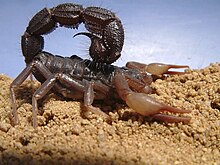
Delta atracotoxin is a low-molecular-weight neurotoxic polypeptide found in the venom of the Sydney funnel-web spider.
Kurtoxin is a toxin found in the venom of the South African scorpion Parabuthus transvaalicus. It affects the gating of voltage-gated sodium channels and calcium channels.

Calciseptine (CaS) is a natural neurotoxin isolated from the black mamba Dendroaspis p. polylepis venom. This toxin consists of 60 amino acids with four disulfide bonds. Calciseptine specifically blocks L-type calcium channels, but not other voltage-dependent Ca2+ channels such as N-type and T-type channels.
Tityustoxin is a toxin found in the venom of scorpions from the subfamily Tityinae. By binding to voltage-dependent sodium ion channels and potassium channels, they cause sialorrhea, lacrimation and rhinorrhea.
Birtoxin is a neurotoxin from the venom of the South African Spitting scorpion. By changing sodium channel activation, the toxin promotes spontaneous and repetitive firing much like pyrethroid insecticides do
AETX refers to a group of polypeptide neurotoxins isolated from the sea anemone Anemonia erythraea that target ion channels, altering their function. Four subtypes have been identified: AETX I, II, III and K, which vary in their structure and target.
BmKAEP is a neurotoxin from the venom of the Manchurian scorpion (Mesobuthus martensii). It is a β-toxin, which shift the activation voltage of sodium channels towards more negative potentials.
Altitoxin is a neurotoxin found in the South African scorpion Parabuthus transvaalicus. Injection of altitoxin in mice leads to akinesia, depression and death.
Dortoxin is a lethal peptide toxin which is secreted by the South African spitting scorpion Parabuthus transvaalicus. Injection of pure dortoxin in mice leads to hyperactivity that lasts until death.
Bukatoxin is an α-scorpion toxin found in the venom of the Chinese scorpion Buthus martensi Karsch. By blocking the inactivation of sodium ion channels, α-scorpion toxins prolong action potentials.
Ikitoxin is a neurotoxin from the venom of the South African Spitting scorpion that targets voltage-sensitive sodium channels. It causes unprovoked jumps in mice following intracerebroventricular injections.
Halcurin is a polypeptide neurotoxin from the sea anemone Halcurias sp. Based on sequence homology to type 1 and type 2 sea anemone toxins it is thought to delay channel inactivation by binding to the extracellular site 3 on the voltage gated sodium channels in a membrane potential-dependent manner.
Spinoxin is a 34-residue peptide neurotoxin isolated from the venom of the Malaysian black scorpion Heterometrus spinifer. It is part of the α-KTx6 subfamily and exerts its effects by inhibiting voltage-gated potassium channels, specifically Kv1.2 and Kv1.3.
LmαTX3 is an α-scorpion toxin from Lychas mucronatus. that inhibits fast inactivation of voltage gated sodium-channels (VGSCs).

Noxiustoxin (NTX) is a toxin from the venom of the Mexican scorpion Centruroides noxius Hoffmann which block voltage-dependent potassium channels and calcium-activated potassium channels.
Beta-mammal toxin Cn2, also known as Cn2 toxin, is a single chain β-scorpion neurotoxic peptide and the primary toxin in the venom of the Centruroides noxius Hoffmann scorpion. The toxin specifically targets mammalian Nav1.6 voltage-gated sodium channels (VGSC).

Delta hexatoxin Hv1 is a neurotoxic component found in the venom of the Australian funnel web spider.
Ts8 is a neurotoxin present in the venom of the Brazilian yellow scorpion, Tityus serrulatus. Ts8 is a selective inhibitor of the voltage-gated potassium channel Kv4.2
Tb1 is a neurotoxin that is naturally found in the venom of the Brazilian scorpion Tityus bahiensis. Presumably by acting on voltage-gated sodium channels, it triggers excessive glutamate release, which can lead to both behavioral and electrographic epileptiform alterations, as well as neuronal injury.

RTX-III (neurotoxin-III,δ-SHTX-Hcr1a) is a neurotoxin peptide derived from the Sebae anemone Radianthus crispa. The toxin targets voltage-dependent sodium channels by preventing its complete inactivation, which can lead to a prolonged influx of sodium ions and depolarization of the cell's membrane.





